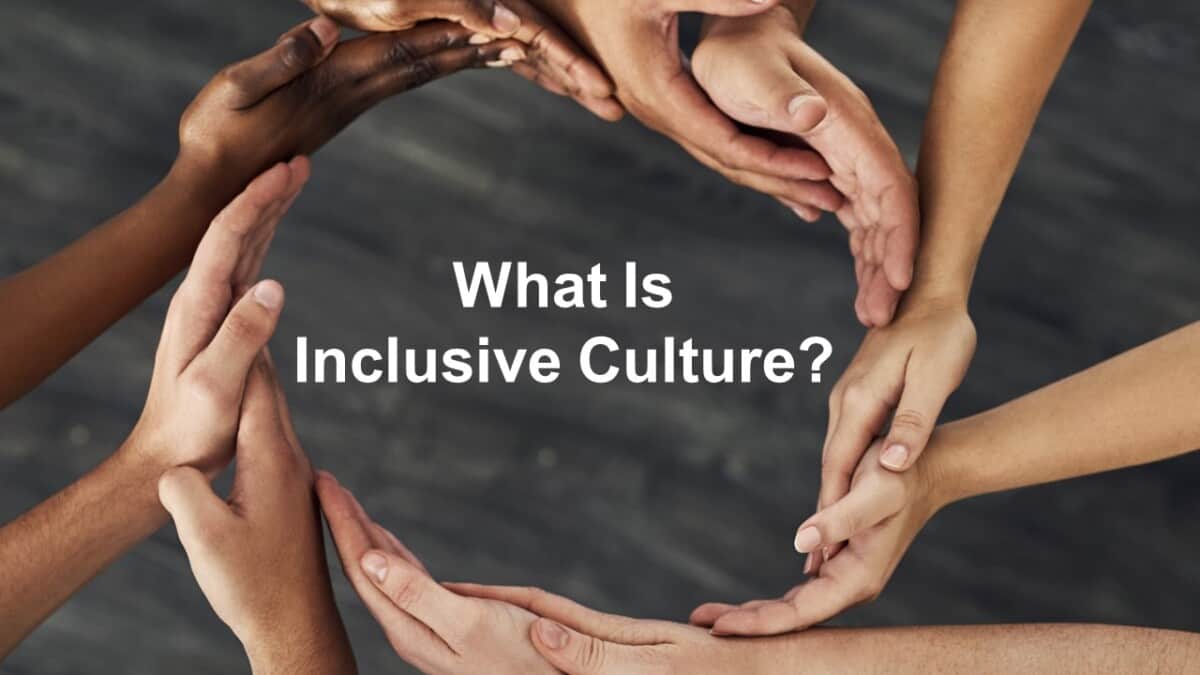Share:

You have probably seen and heard the word “inclusion” being thrown around a lot lately as part of a broader discussion on the validity of diversity, equity, and inclusion (DEI) initiatives.
While there are some who say DEI policies and practices lack value, make spurious claims that they are somehow discriminatory, or are to blame for the occurrence of completely unrelated events, good leaders know initiatives that promote diversity, equity, and inclusion are essential for high performance, retention, innovation, profitability, and a number of other positive business outcomes.
DEI is crucial for building talented teams of engaged, motivated employees, and organizations with diverse, inclusive teams have an advantage over their less diverse, less inclusive competitors.
But, to gain this advantage, we have to get serious about DEI and make efforts that go beyond those yearly diversity training videos. The key to building diverse teams that can achieve the positive business outcomes we desire is fostering a culture of inclusion within our organizations.
An inclusive culture is a workplace culture that is supportive of and respectful toward all employees. Organizations with inclusive cultures embrace differences in backgrounds and experiences and build high-performing teams of employees who are engaged with their work and invested in the organization’s success.
In this article, I will look at what goes into building an inclusive culture, how it can give your organization a competitive advantage, and the role leaders can play in ensuring their organizations champion inclusion.


DEI Explained
DEI describes policies and initiatives that support and promote the representation and participation of different groups of individuals regardless of age, race, religion, ethnicity, gender, sexual orientation, or disability.
The concepts of diversity, equity, and inclusion are different but interrelated concepts. Let’s unpack the meanings of each term.
Diversity: Diversity encompasses the range of similarities and differences each individual brings to the workplace, including (but not limited to) language, race, national origin, ethnicity, gender, age, religion, sexual orientation, disability, and socioeconomic status.
Equity: Gallup defines equity as the fair treatment, access, and advancement of each person in an organization, including fairness in pay, fairness in daily work experiences, and opportunities for advancement.
Inclusion: Inclusion is defined as “the policy of providing equal access to opportunities and resources for people who might otherwise be excluded or marginalized.”
In DEI, the concepts of diversity, equity, and inclusion function together in ways that support fair and respectful work environments for all. DEI initiatives, strategies, and policies are focused on equal access and equal opportunity for the underrepresented and promoting diverse backgrounds, experiences, and expertise to improve business sustainability and recruitment processes.
These initiatives help organizations to identify and eliminate (or, at the very least, reduce) policies, practices, and behaviors that are biased.
What Is Inclusive Culture?
Organizations may implement a few inclusive policies here and there or have a statement about inclusion on their website, but it takes more to create an inclusive environment. It requires a deep commitment at every level of the organization (particularly senior leadership) to create a culture that makes inclusion a priority.
Inclusive workplace culture ensures that the contributions, talents, skills, and perspectives of all employees are welcomed and utilized in ways that help organizations achieve their vision.
To stay motivated and consistently perform well, employees need a work environment that offers them a positive employee experience and where every team member feels empowered and supported.
Inclusive culture in the workplace supports a positive employee experience for all and creates the psychological safety employees need to work well with each other and unite around a shared vision.
It creates an environment where each employee feels a sense of belonging and is comfortable bringing their authentic self to work every day without the fear of being ostracized or marginalized by their co-workers.
Inclusive culture is also essential for building diverse teams and ensuring equitable treatment.
While many businesses understand the importance of diversity, they often undermine their own attempts at diversity because they’ve failed to create a psychologically safe environment and inclusive culture for everyone.
Without inclusion, diversity and equity initiatives are less effective. To see the positive impacts of diversity and equity, we have to create an inclusive work environment that is supportive of diversity and equity first.
The Benefits of Inclusive Culture
According to Trish Foster, executive director at the Center for Women and Business, workers are shaped by their backgrounds, cultures, experiences, and personalities. And organizations see big benefits when they have cultures that embrace these differences.
Foster says, “Organizations that blend people who think differently from each other—analytical workers, conceptual thinkers, creative spirits, or detail-oriented employees—can create energy to drive new ideas and productivity.”
Here are just a few ways inclusive cultures can benefit an organization:
Collaboration
Fostering a sense of belonging is key to engaging employees and building camaraderie among team members, which can positively impact collaboration. The sense of belonging employees feel when they work in an inclusive environment unites them with a shared sense of purpose that can boost collaborative efforts.
Innovation
Organizations can benefit immensely from including diverse points of view because they spur innovation, make teams more adaptable, lead to creative solutions, and create unique opportunities for collaboration with team members and clients. Organizations with above-average diversity scores have reported higher innovation revenues.
Recruitment
Eliminating bias and discriminatory practices from the selection process can open up the recruitment process to a wider pool of highly qualified candidates and improve the overall quality of hires. It can also have a positive effect on how potential candidates view the company.
Research found that 86% of millennial women considered diversity and inclusion policies important. According to a 2018 Randstad study, 78% of employees surveyed said they valued equal workplaces. As Gen Z—a generation of workers that has demonstrated strong support for diversity, equity, and inclusion—continues to enter the workforce, this percentage is expected to grow.
Customer Satisfaction
Organizations are better able to serve diverse groups of customers and avoid marketing approaches that fall flat when they have diverse teams. To truly leverage the power of diverse teams requires an inclusive culture where diverse perspectives are embraced. Remember: representation matters to customers, so it should matter to the businesses that serve them.
Engagment
Inclusive environments that champion diversity are good for improving engagement, which can profoundly impact an employee’s performance, the success of collaborative team efforts, and an organization’s retention.
Retention
Employees will leave an organization where they do not feel psychologically safe, heard, or valued. They are more likely to stay in an organization with inclusive policies that support a sense of belonging and an appreciation for the diverse perspectives and needs of all employees.
Profitability
All these benefits are good for profitability, but just how good? According to a 2012 McKinsey study, US companies with diverse executive boards had a 95% higher return on equity than those that lack diversity. More on this in the next section.
Inclusive Culture and the Bottom Line
I’d like to speak more on the issue of profitability and how it can be impacted by inclusive culture, or, rather, the lack of inclusive culture. Whatever one’s personal views are on this topic, there is no denying the financial impact inclusive culture can have on an organization.
One of the ways a lack of inclusion can negatively impact a company’s bottom line is that it makes organizations more susceptible to toxic practices and behaviors.
For employees to engage with their work and perform well, they need to feel that they are both valued by their co-workers and that their co-workers share the core values that help them find a sense of purpose in their work.
Unfortunately, when work cultures turn toxic, work environments turn toxic, employees start to become disengaged, their work becomes less purposeful for them, and, eventually, they leave.
Nothing will make an employee disengage faster and seek out other opportunities than a work environment where they are subjected to microaggressions on a daily basis, where they must constantly engage in code-switching to feel like they “fit in” with the majority of their co-workers, or where difference is used to divide employees or limit their participation.
Toxic work cultures have been cited as one of the main factors driving turnover over the last year, proof that when work environments are negative, organizations will lose talented employees. This means they will also lose money. And the bias and discrimination that lead to toxic work environments can be costly.
In fact, unconscious bias costs US businesses $550 billion annually, a point that is rarely mentioned in the debate over the effectiveness of DEI initiatives, but it’s important to consider that figure as we continue to identify ways to make our organizations more sustainable, more adaptable, and more profitable.
Fostering inclusive work environments that are inhospitable to toxic behaviors and microaggressions that can alienate otherwise engaged employees is the key to keeping our companies sustainable and profitable in the long term.


How To Foster an Inclusive Culture: The Case for Compassionate and Inclusive Leadership
Leaders, more than any other factor in an organization, impact culture. In other words, leaders set the tone for inclusive cultures in their organizations.
The actions and behaviors of leaders make a 70% difference as to whether an employee feels included. When they feel included, they are more likely to give helpful feedback, go above and beyond to get the job done, and engage in collaborative efforts.
The key to leadership is inspiring team members to strive for continuous improvement, reach their full potential, and do great work. One of the main ways leaders can help their team members to do great work is by leading compassionately.
But to ensure you are creating the necessary conditions for team members to do great work, you have to ensure that you are creating the necessary conditions for all team members within the organization to do great work.
This means leading your team with a compassionate approach that demonstrates a commitment to inclusion.
Compassionate and inclusive leadership is the coalescence of two important roles leaders play in helping their people engage with their work and perform well. Compassionate and inclusive leaders build strong connections with all team members through awareness and actions that support their growth and well-being.
Compassionate Leadership
Compassionate leadership combines traditional leadership skills with empathy, sympathy, and compassion.
Sympathy helps us feel sorrow for another’s misfortune. Empathy helps us understand and share the feelings of another.
The key to compassion, and what differentiates it from empathy, is that compassion spurs us to act to alleviate suffering. The compassionate leader doesn’t just offer empathy, they take actions to relieve suffering.
Compassionate leadership focuses on building strong relationships with employees by making them feel valued and cared for so that they can do great work in a sustainable way.
Compassionate leaders have positive intentions, express real concern for their employees, and help them remove obstacles to meet their potential. These leaders aren’t just interested in performance and productivity; they are interested and invested in their employees’ success and ensuring their work lives aren’t causing harm to their well-being.
According to John Baldoni, author of Grace Under Pressure: Leading Through Change and Crisis, they are also proactively compassionate.

Inclusive Leadership
Inclusive leaders have a high degree of self-awareness and are committed to helping all team members succeed. They support and reinforce inclusive cultures, guided by inclusive core values.
These leaders view diversity as an asset that makes their business more competitive, more innovative, and more profitable. They encourage employee participation in decision-making, foster a work environment that is conducive to effective collaboration, and consider diverse perspectives to be part of any sustainable business strategy.
Inclusive leadership places an emphasis on equitable and fair treatment, growth and development of team members, a sense of belonging and camaraderie, respect, trust, collaboration, and creating a shared sense of purpose that keeps employees motivated.
Compassionate and Inclusive Leaders Foster Inclusive Cultures
Leaders play a critical role in communicating an organization’s vision to employees and providing the necessary conditions for them to achieve that vision.
Uniting employees with a shared sense of purpose is key to motivating them to work as a team to achieve the vision. Maintaining a positive, inclusive work environment that supports all team members is critical to uniting employees around the vision.
Leaders who want to create work environments where all team members feel that important sense of psychological safety and belonging they need to thrive lead with compassion.
When leaders model compassionate and inclusive behaviors, they are setting the tone for an organizational culture that values diversity, gives employees a voice, helps employees grow and develop, and inspires and empowers employees to do great work.

Matt Tenney has been working to help organizations develop leaders who improve employee engagement and performance since 2012. He is the author of three leadership books, including the groundbreaking, highly acclaimed book Inspire Greatness: How to Motivate Employees with a Simple, Repeatable, Scalable Process.
Matt’s ideas have been featured in major media outlets and his clients include numerous national associations and Fortune 500 companies.
He is often invited to deliver keynote speeches at conferences and leadership meetings, and is known for delivering valuable, actionable insights in a way that is memorable and deeply inspiring.


